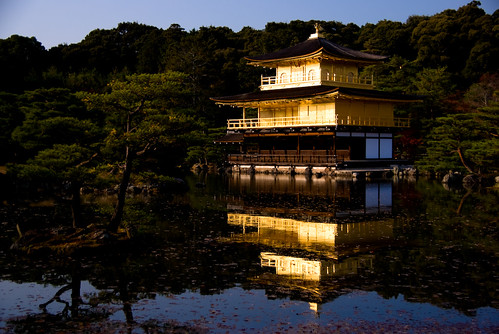
Kinkaku-ji (金閣寺, Kinkaku-ji?) or "Golden Pavilion Temple" is the informal name of Rokuon-ji (鹿苑寺, Rokuon-ji?) or "Deer Garden Temple" in Kyoto, Japan. It was originally built in 1397 to serve as a retirement villa for Shogun Ashikaga Yoshimitsu, as part of his estate then known as Kitayama.[1] It was his son who converted the building into a Zen temple of the Rinzai school. The temple was burned down twice during the Ōnin War.
The Golden Pavilion, or Kinkaku, is a three-story building on the grounds of the temple. The top two stories of the pavilion are covered with pure gold leaf. The pavilion functions as a shariden, housing relics of the Buddha (Buddha's Ashes). The building is often linked or contrasted with Ginkaku-ji, the Silver Pavilion Temple, which is also located in Kyoto.
The Golden Pavilion is set in a magnificent Japanese strolling garden (kaiyū-shiki). The pond in front of it is called Kyōko-chi (Mirror Pond). There are many islands and stones on the pond that represent the Buddhist creation story.
In 1950, the pavilion was burned down by a monk, who then attempted suicide on the Daimon-ji hill behind the building. He survived, but during the investigation after the monk's arrest, his mother was called in to talk with the police; on her way home, she committed suicide by jumping from her train into a river valley. The monk was sentenced to seven years in prison; he died of illness during his imprisonment in 1956. At that time, the statue of Ashikaga Yoshimitsu was burned. A fictionalized version of these events is at the center of Yukio Mishima's 1956 book The Temple of the Golden Pavilion.
"A journey of a thousand miles must begin with a single step." -- Lao Tzu
Copyright © Demetrios the Traveler


No comments:
Post a Comment